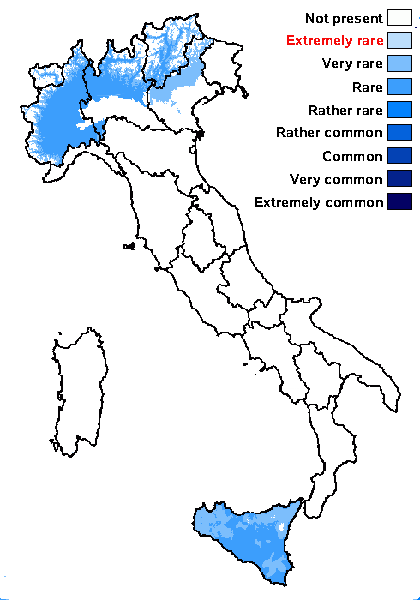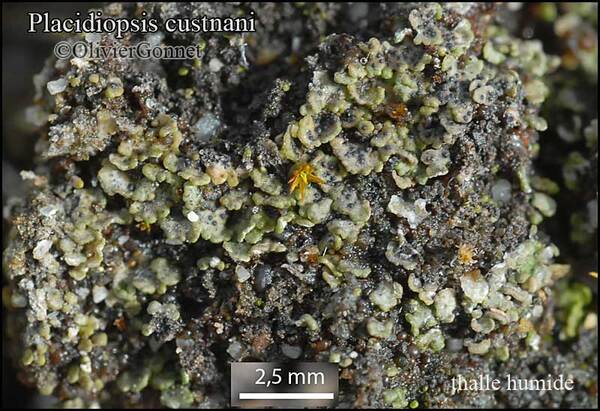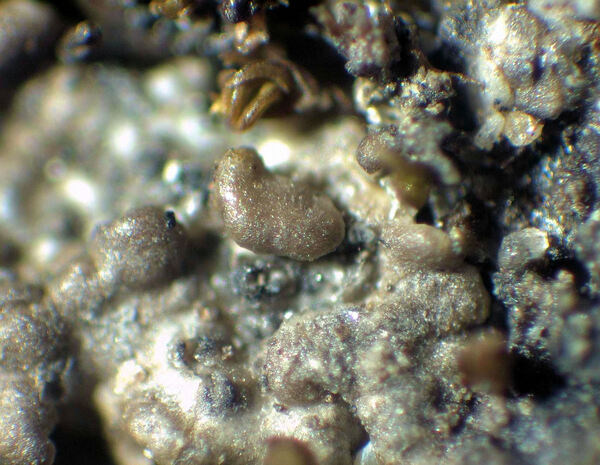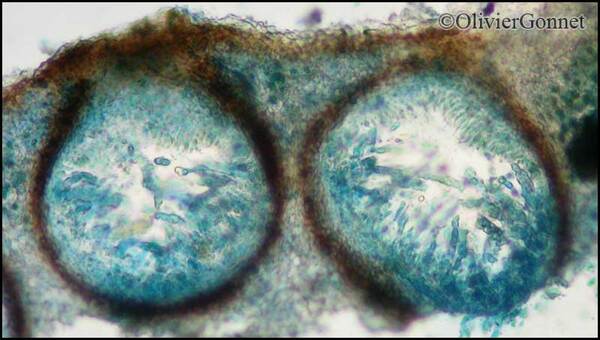Placidiopsis custnani (A. Massal.) Körb.
Parerga Lichenol.: 305, 1863. Basionym: Placidium custnani A. Massal. - Lotus, 6: 78, 1856.
Synonyms: Catapyrenium custnani (A. Massal.) Jatta; Dermatocarpon crenulatum (Nyl.) Mig.; Endocarpidium custnani (A. Massal.) Müll. Arg.; Endocarpon cinereum var. cartilagineum Nyl.; Paraplacidiopsis crenulata (Nyl.) Servít; Placidiopsis cartilaginea (Nyl.) Vain.; Placidiopsis crenulata (Nyl.) Zschacke; Verrucaria crenulata (Nyl.) Nyl.
Distribution: N - Ven (Lazzarin 2000b, Breuss 1996b), TAA (Nascimbene & al. 2022), Lomb, Piem, VA (Piervittori & Isocrono 1999). S - Si (Breuss 1996b).
Description: Thallus squamulose, the squamules crenate-lobulate, scattered to usually contiguous, pale olive brown to brown, olive-green when wet, up to 2-3(-4) mm wide, 0.2-0.4(-0.5) mm thick, the margins ascending and down-rolled; lower surface dark brown to black, paler towards margins. Upper cortex very thin, paraplectenchymatous, composed of 1-2 layers of globose cells, overlain by an up to 30 µm thick epinecral layer; medulla white, of thin-walled, globose cells; lower cortex not developed. Rhizohyphae brown, in the central part usually aggregated into a stout, rhizine-like holdfast. Perithecia black, broadly pyriform to globose, 1-5 per squamule, 0.2-0.23 mm across, immersed, without involucrellum. Exciple blackish brown in upper part, pale below, of tangentially arranged cells; periphyses present around the ostiole, 20-30 x 2-3 μm, interascal filaments absent; hymenial gel hemiamyloid. Asci 8-spored, clavate, thin-walled, the apical region slightly thickened, with a small ocular chamber, K/I-, 50-70 x 10-14 μm. Ascospores 1-septate, hyaline, ellipsoid to fusiform, (12-)14-20(-22) x 5.5-7.5 μm, thin- and smooth-walled, biseriately arranged in the asci. Photobiont chlorococcoid (Diplosphaera). Spot tests: cortex and medulla K-, C-, KC-, P-, UV-. Chemistry: without lichen substances.Note: an overlooked terricolous lichen found on calciferous soil and calcicolous mosses which, in Italy, seems to be most common in the submediterranean belt. Most of the records are from the Alps.
Growth form: Crustose
Substrata: soil, terricolous mosses, and plant debris
Photobiont: green algae other than Trentepohlia
Reproductive strategy: mainly sexual
Commonnes-rarity: (info)
Alpine belt: absent
Subalpine belt: absent
Oromediterranean belt: absent
Montane belt: very rare
Submediterranean belt: rare
Padanian area: absent
Humid submediterranean belt: very rare
Humid mediterranean belt: very rare
Dry mediterranean belt: rare

Predictive model


P.L. Nimis; Owner: Department of Life Sciences, University of Trieste
Herbarium: GZU - Vezda Lich.Sel.Exs. (951)
2003/04/28


P.L. Nimis; Owner: Department of Life Sciences, University of Trieste
Herbarium: GZU - Vezda Lich.Sel.Exs. (951)
2003/04/28

Courtesy Danièle et Olivier Gonnet - Source: https://www.afl-lichenologie.fr/Photos_AFL/Photos_AFL_P/Text_P_2/Placidiopsis_custnani.htm
France, 8/7/2011 - Miribel Jonaje - Rhöne

Courtesy Danièle et Olivier Gonnet - Source: https://www.afl-lichenologie.fr/Photos_AFL/Photos_AFL_P/Text_P_2/Placidiopsis_custnani.htm
France, 8/7/2011 - Miribel Jonaje - Rhöne
Growth form: Crustose
Substrata: soil, terricolous mosses, and plant debris
Photobiont: green algae other than Trentepohlia
Reproductive strategy: mainly sexual
Commonnes-rarity: (info)
Alpine belt: absent
Subalpine belt: absent
Oromediterranean belt: absent
Montane belt: very rare
Submediterranean belt: rare
Padanian area: absent
Humid submediterranean belt: very rare
Humid mediterranean belt: very rare
Dry mediterranean belt: rare

Predictive model


P.L. Nimis; Owner: Department of Life Sciences, University of Trieste
Herbarium: GZU - Vezda Lich.Sel.Exs. (951)
2003/04/28


P.L. Nimis; Owner: Department of Life Sciences, University of Trieste
Herbarium: GZU - Vezda Lich.Sel.Exs. (951)
2003/04/28

Courtesy Danièle et Olivier Gonnet - Source: https://www.afl-lichenologie.fr/Photos_AFL/Photos_AFL_P/Text_P_2/Placidiopsis_custnani.htm
France, 8/7/2011 - Miribel Jonaje - Rhöne

 INDEX FUNGORUM
INDEX FUNGORUM
 GBIF
GBIF
 DOLICHENS
DOLICHENS




